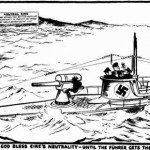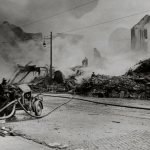
The history of Northern Ireland in the half century after Partition is often overlooked or disregarded. Yet studying this period turns up several causes of sectarian tension and violence in the late 1960s. The division of Ireland in 1920 was intended to be temporary, a means of facilitating Home Rule until the situation in Ireland settled and reconciliation and reunification was possible. In 1922 representatives from London and Dublin nations signed the Anglo-Irish Treaty, an agreement that established the Irish Free State, in effect a self-governing British dominion. But this failed to satisfy Nationalists in the south, who wanted to extricate themselves from British rule entirely. Southern Ireland tumbled into a brief but bloody civil war between the IRA and Republicans who opposed the Treaty, and the moderate Nationalists who supported it. The latter emerged victorious and in December 1922 formed the Irish Free State, a self-governing dominion of Great Britain. The Free State survived until 1937 when Nationalist politicians, who had by now abandoned revolution for reform, engineered a new constitution that expunged most of the state’s obligations to Britain. Ireland became a de facto republic, a transition that was formally completed in 1948.
The birth of Northern Ireland
But these changes did not affect people in the Six Counties of Ulster. In December 1922 the government of Northern Ireland exercised its rights under the Anglo-Irish Treaty and dissolved its association with Dublin. A government decree, issued two days after the formation of the Irish Free State, told King George V that “the powers of the parliament and government of the Irish Free State shall no longer extend to Northern Ireland.” Instead, Stormont chose to return to British rule. The development of the Irish Republic in the 1930s further extended the gulf between Belfast and Dublin. The partition of Ireland, passed in 1920 as a temporary measure, had become a permanent feature of the political landscape in Ireland. But the existence of Northern Ireland was not accepted by all, particularly radical Republicans, who considered partition an illegal act forced on Ireland by an imperial power. The only genuine solution, they argued, was a republic that encompassed the whole of Ireland. There were also concerns about the Catholic and Nationalist minority living under a Unionist government in Northern Ireland.

Both the Irish Free State and Northern Ireland suffered during the Great Depression that afflicted Europe during the 1930s. In 1937 the Free State voted to repeal its 1922 constitution, replacing it with a document that acknowledged the British presence in Ireland but dissolved most of Dublin’s constitutional obligations to Britain. The 1937 constitution replaced the governor-general with a president, who gave assent to laws and otherwise acted as a head of state. Ireland became a de facto republic, attached by Britain only by thin titular bands. When World War II erupted in 1939, Northern Ireland dutifully followed Britain into the war but the South remained neutral. Fearful of a Nazi-IRA alliance, London courted the Irish government by promising the reunification of Ireland in return for a full military alliance. Dublin refused this offer but later agreed to provide significant wartime support to Britain, such as the use of Irish land and ports. Meanwhile the IRA, now an illegal organisation in their own country, declared war on Britain. From early 1939 to mid-1940 the IRA initiated its S-Plan, carrying out more than 30 bombings in England that killed seven people.
Sectarian violence in Ulster
Northern Ireland too saw plenty of violence in the years following partition. Rioting erupted across the Six Counties, particularly in Belfast, in the early 1920s. This unrest was not only driven by politics and religion; the collapse of major industries pushed Northern Ireland’s unemployment towards 20 percent, so competition for jobs soon became intense. In July 1920 these tensions peaked when Protestants marched on the Harland and Wolff shipyards – the birthplace of the RMS Titanic and one of Belfast’s largest employers – and forced thousands of Catholics out of their jobs. Riots broke out across the city and 20 people were killed in just three days. Violence continued broke out periodically in Northern Ireland, sometimes in response to political events such as the declaration of the Irish Free State. Between mid-1920 and late-1922, a total of 465 people died in Belfast alone, while some 20,000 Catholics were forced from their homes. Sectarian riots broke out again in Belfast in 1935, following a Protestant procession on the anniversary of the Battle of the Boyne. Four people were killed, at least two of them civilians, while another 30 were injured. Massive damage occurred around York Street and the military was called in to calm the situation.

Northern Ireland also suffered at the hands of the Germans during World War II. Thinking itself a distant and unlikely target, Belfast did little to prepare for Nazi air raids – but the city’s shipyards made it an important strategic target for the Luftwaffe (German air force). In April and May 1940, Belfast was subject to dozens of raids. The worst came on April 15th when 200 German bombers pounded the city relentlessly, destroying factories, infrastructure and housing. More than 900 Belfast residents were killed, one of the war’s highest single-day civilian death tolls. The bombing destroyed half the city’s housing, leaving one-quarter of its population homeless. The situation improved after the war, aided by the British government’s implementation of a national welfare state. Housing, health and education, previously the responsibility of the under-resourced Northern Ireland government, were now administered and funded by Westminster. Northern Ireland received more than 100,000 new dwellings, while its citizens received national insurance and family allowances. Nationally-funded programs also created new jobs and boosted infrastructure spending and industrial development. This new prosperity was welcomed by Ulster’s Catholics and alleviated some of their fears about discrimination, marginalisation and forced poverty.
Post-war divisions and discrimination
“Northern Ireland continued as a part of Britain and post-war innovations, such as the National Health Service, were extended to include the province. There was a period of rebuilding those parts of Belfast and elsewhere that he been damaged during the war, and industries such as shipbuilding gained short-term benefits from restocking the naval and merchant fleets lost in the war. Politically, everything continued as before in Northern Ireland. The Protestant and Unionist majority continued in control of Stormont and the Catholic population was left without any say in government (apart from a few local councils) and treated as second-class citizens. All this would lead to a growing sense of disquiet in Northern Irish society that would explode into violence at the end of the 1960s.”
Mike Cronin, historian
Yet despite this post-war optimism, segregation and sectarianism remained part of the social landscape in Northern Ireland. This was particularly true in large cities like Belfast and Derry, where residential areas, schools and workplaces became overwhelmingly divided. Sometimes this segregation was the outcome of government policy or planning – but it was also the product of social choices or pressures, from within one’s community as well as from the other side. It was very rare that Catholics and Protestants lived together in numbers; their communities occasionally tolerated individual families or small pockets of the other, provided they were apolitical and kept to themselves. In the late 1960s, a demographic study of Shankill (99 percent Protestant) and Clonard (98 percent Catholic) found that residents in these areas lived discretely from their sectarian opposites. Catholics and Protestants not only lived in different suburbs, they also read different newspapers, frequented different shops and pubs, played in and supported different sporting teams. It was not only a case of Protestants purposefully shunning Catholics and vice versa; they simply did not encounter each other in their day to day lives. Each remained at arm’s length, ignorant of the politics, culture and values of the other.

There were occasional attempts, usually by liberal-minded reformers, to break through segregation. One of the earliest of these came from Lord Londonderry, Stormont’s education minister in the 1920s, who tried to create integrated schools. Londonderry’s reforms, like numerous others since, died in a chorus of protest. For the most part, however, Northern Ireland’s Unionist governments sought to foster these divisions rather than heal them. In 1929 the Unionists moved to strengthen their grip on government by abolishing proportional representation, a voting system that ensured fair and equal parliamentary representation for all groups, regardless of political or religious affiliation. The government also engaged in gerrymandering, carefully drawing up electoral boundaries to disperse Catholic voting power and enhance the Unionist majority. Local government electoral laws also favoured Protestants over Catholics. Voting was restricted to ratepayers, who were entitled to a vote for each property they owned, to a maximum of six votes. Tenants, however, were not entitled to vote at all, a restriction that greatly disadvantaged Catholics. Local councils came to be dominated by Protestants, whose decisions on housing allocations and spending priorities favoured other Protestants.

1. In 1922 Northern Ireland’s Unionist leaders opted out of the Anglo-Irish Treaty, severing its ties with Dublin.
2. In the south, the Irish Free State began to evolve into an independent republic, a process completed in 1948.
3. During the 1920s and 1930s, Northern Ireland continued to suffer from political and sectarian violence.
4. Northern Ireland benefited from post-World War II reconstruction, receiving a welfare system and new housing.
5. Catholics benefited from this post-war revival, however Northern Ireland evolved into a segregated society where Catholics and Protestants lived separate lives, while government and business came to be dominated by Protestant Unionists, to the detriment of Catholics.
© Alpha History 2017. Content on this page may not be republished or distributed without our express permission. For more information please refer to our Terms of Use.
This page was written by Rebekah Poole and Jennifer Llewellyn. To reference this page, use the following citation:
R. Poole and J. Llewellyn, “Northern Ireland before 1968”, Alpha History, accessed [today’s date], https://alphahistory.com/northernireland/northern-ireland-before-1968/
